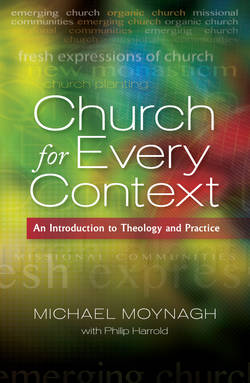Читать книгу Church for Every Context - Michael Moynagh - Страница 43
На сайте Литреса книга снята с продажи.
Church took its shape from future leaders
ОглавлениеIt is also striking how the New Testament church was sculpted round the most pervasive form of leadership in ancient society – leadership within the household. Whereas synagogues moved out of the home as the congregation grew, there is no sign of this happening in the primitive church.15 Church gatherings remained firmly house bound. Was this partly because finding leaders for new congregations became relatively simple when believers gathered round an existing household, which had leadership already in place?
Gehring, supported by Dunn (2009, p. 571), argues that Paul deliberately concentrated on more wealthy people when he entered a town because they were potential leaders and their homes would provide a base of operations. He did this with Lydia at Philippi for instance (Acts 16.13–5), and also at Corinth. Remarkably, even though most of the Corinthian Christians had comparatively low social origins (1 Cor. 1.26), Paul broke his rule of not baptizing converts only in the case of three households – and these were from the upper economic strata (vv. 14–7).
‘The church in the house came with its leadership so to speak “built in”’ (Gehring, 2004, pp. 185–7; 194). Among the more wealthy, household heads were educated, had experience of teaching their own families and had financial responsibility for the home. They were well equipped, therefore, to lead a gathering based on their households and to share in the leadership of the church city wide.
Most likely, leadership tended to take the form of ‘love-patriarchalism’. The social order was retained, but mutual love based on the gospel was fostered by household heads serving as leaders of the congregations in their homes. In poorer areas, where there was no patron to function as a leader, leadership may have been collective rather than hierarchical (Jewett, 2007, pp. 65–6). Though the author had no connection to Paul, might such a context be in mind in Matthew 18.17, where disputes between brethren are to be taken to the church rather than to church leaders?
For reflection
Knowledge of the Old Testament meant that Paul’s Jewish and ‘God-fearing’ converts had good foundations for Christian faith, which made it easier for Paul to move on rapidly. By contrast in our culture, where increasingly people have little or no knowledge of the Bible, bringing a church to birth is likely to take much longer. Is it realistic to expect church founders to leave anything like as fast as did Paul?
Paul seems to have founded leadership-shaped churches that took their structure in part from the nature of leadership in their contexts. Might communities that fit the available leadership be crucial in birthing sustainable churches today? If new churches take their shape from the available leadership, what difference would it make? How would this work in poor urban areas where there is often an acute shortage of leadership?
